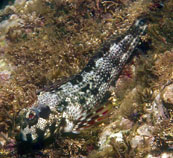|
Scartella caboverdiana Bath, 1990 |

|
|
photo by
Wirtz, P. |
| Family: | Blenniidae (Combtooth blennies), subfamily: Salariinae | |||
| Max. size: | 6 cm TL (male/unsexed) | |||
| Environment: | demersal; marine | |||
| Distribution: | Eastern Central Atlantic: Cape Verde. | |||
| Diagnosis: | Dorsal spines (total): 12-12; Dorsal soft rays (total): 15-16; Anal spines: 2-2; Anal soft rays: 16-17 | |||
| Biology: | Adults occur in intertidal areas (Ref. 27000). Oviparous. Eggs are demersal and adhesive (Ref. 205), and are attached to the substrate via a filamentous, adhesive pad or pedestal (Ref. 94114). Larvae are planktonic, often found in shallow, coastal waters (Ref. 94114). | |||
| IUCN Red List Status: | Least Concern (LC); Date assessed: 23 March 2011 Ref. (130435) | |||
| Threat to humans: | harmless | |||